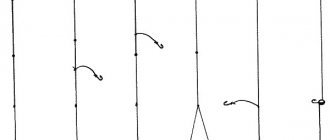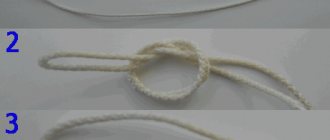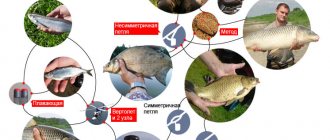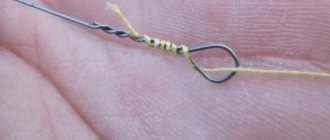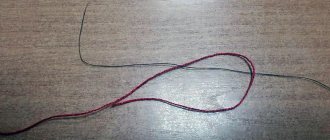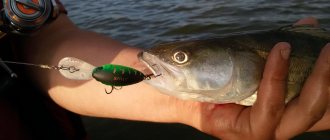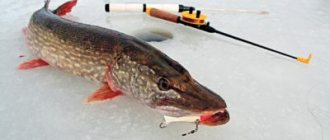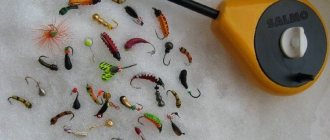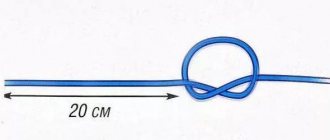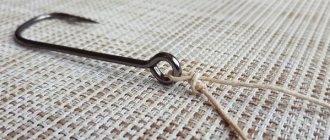What is donka
Donka is a tackle with which fishermen catch fish from the bottom of a reservoir and in the bottom layer. With or without a rod, with a spring or simply with a weight, the bottom is supplied with bait or lure to the fish, which are accustomed to feeding not from the surface of the water, but in the lower water horizons. We can say that the equipment of a bottom fishing rod is the most numerous of all the equipment that is used in fishing.
They catch with a donkey:
- carp;
- tench;
- blue;
- grass carp;
- soma;
- bream;
- bull;
- perch;
- pike perch.
This is only a short list of fish that are caught on the bottom, because even roach, accustomed to moving in search of food in all depths, will certainly be interested in the tasty treat lying on the bottom.
Requirements for a donkey
Although donk designs vary, there are general requirements that they must meet. These requirements do not depend on the specifics of the fishing location, the type of reservoir and the time of fishing.
Bottom tackle should:
- present the bait at the bottom, or in the bottom layer;
- detect fish after biting;
- ensure reliability when fishing the trophy;
- quickly sort out and pack up after fishing;
- be compact and easy to transport.
There are differences between, say, a donkey for catfish or crucian carp, but they are not fundamental and primarily relate to the reliability of the equipment. When catching cautious fish, stealth of the gear is especially important, and anglers have to use thin lines and small hooks.
But when it comes to big fish, the reliability of the gear comes to the fore. There are situations when, when catching the same crucian carp, a carp or carp is caught on the hook and it is offensive due to the fault of the delicate equipment. But as they gain experience, anglers learn to catch trophy fish using thin gear and many problems are solved on their own.
Fishing with bottom rigs involves waiting for a bite, rather than tempo fishing, so they use not one, but several bottom rigs. Thus, the fisherman increases his chances of a good catch, and the waiting time passes faster. It is important to understand how to properly set up the donkey and, in general, which version of the tackle will show the best result in certain conditions.
Not every fisherman is able to buy donkeys in stores, so the ability to tie budget-friendly but catchy gear also plays a big role. There are examples when simple donks that cost a penny were used to catch trophies that one can only be proud of. And the presence of expensive rods, reels and other equipment does not guarantee an outstanding catch.
Features of attaching multiple leashes
Moreover, more than one side leash can be tied to the main line. There can be several of them, up to three pieces (!). But they need to be connected correctly. And this must be done not only so as not to tangle the leashes, but also so as not to tear them off from the main line.
And this is best done with the help of the so-called “snake knot”, which is knitted like this:
Scheme for tying several leashes with a snake knot
You need to place the main line parallel to the leader line.
It turns out one already tied leash and two freely protruding ends, to which, if you initially make them long, you can tie a couple more leashes. For reliability, you can attach swivels with carabiners to them and attach leashes to them.
In this case, everything depends on imagination, the main thing is not to overdo it and not to make a structure that will clearly scare away the fish. If there is no need for three or even two leashes, then it is better to simply cut off the ends.
What does bottom tackle consist of?
As already mentioned, bottom gear has design differences, but this is rather an exception.
In general they consist of:
- sinkers;
- main line;
- leashes with hooks.
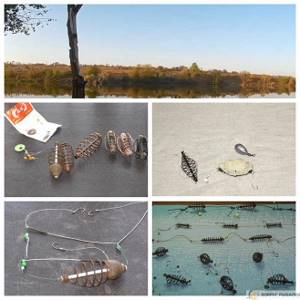
To these three elements are added:
- fishing rods;
- reel;
- coils;
- feeders;
- swivels, beads, carabiners;
- stopper;
- signaling devices;
- stands and stands.
A sinker or various types of weights is a mandatory element of bottom gear, and it serves to hold the equipment near the bottom. There are sinkers that are placed on the fishing line, cast and reeled in along with the equipment.
They are placed on:
- snacks;
- feeder installations;
- method and flat-method gear;
- Donks with spinning rod;
- crucian carp killers;
- bottoms with side outlet;
- Japanese;
- combines;
- makushatniki.
Types of cargo for donks
The shape and weight of the load varies depending on the type of equipment and this can be a loaded feeder (as, for example, in feeder fishing).
The shape of the sinker is:
- rectangular;
- triangular;
- diamond-shaped;
- oval;
- trapezoidal;
- round.
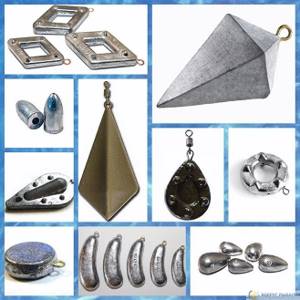
For fishing in still water, any sinker is suitable, but for currents, special weights with lugs are selected that “hold” the bottom well. Beginning fishermen need to consciously choose the shape of the sinker so that fishing is comfortable and the tackle lies in the fishing spot. Rectangular and diamond-shaped sinkers are used with hooks on the current, and round and oval ones are used on the “riser”. When fishing in a reservoir with a silted bottom, choose flat weights that sink less into the silt and do not pull the leash with a hook.
But streamlined sinkers are used when fishing at shallow depths, when it is necessary to make less noise when the equipment hits the water.
Another important characteristic of the sinker is the method of attachment to the fishing line and they are:
- sliding;
- deaf.
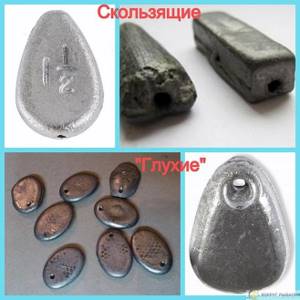
Sliding (or inline) weights have a through hole along the entire length into which the fishing line is threaded when installing the equipment. After casting the tackle, such a sinker lies at the fishing point, and the leashes with the nozzle float in the water column. After the fish takes the bait, it does not feel the resistance of the load until a certain moment, since the line slides through the sinker.
At this time, the signaling device on the shore shows that the main line has started to move and the bait is in the fish’s mouth. The sliding version of the rig has undoubted advantages, especially when catching cautious trophies, but the fisherman needs to be ready to make a timely hook.
Advantages of equipment with inline load:
- sensitivity - cautious fish are not afraid to take the bait, as they do not feel resistance;
- safety - if the gear breaks, the fish will be able to free itself from the hook;
- It is more convenient to throw the tackle over long distances.
Disadvantages of online editing:
- the fisherman must monitor the alarms in order to make a timely hook;
- The installation design is such that it is not possible to quickly change the load.
Blind sinkers are equipped with a swivel or bracket for attaching to the tackle. They are easier to change during fishing, but there are situations when the current increases and the equipment is carried away, or, on the contrary, you need to lighten the equipment.
The main feature of the blind rig is that when a fish bites, it self-hooks under the weight of the load. Carp anglers and fans of feeder fishing actively use such weights (including loaded feeders) on their fishing trips and they help catch trophy fish.
Probably, many have heard from carp fishermen that a “locomotive” happened and this is exactly the case when the trophy caught itself under the weight of the load and there is no need to additionally hook the tackle.
Advantages of blind sinkers:
- self-locking installations are made with them;
- it’s easy and quick to change one sinker to another without dismantling the entire installation;
- fewer idle bites.
Disadvantages of installations with blind loads:
- the sensitivity of the equipment is lower;
- if the gear breaks, it is more difficult for the fish to free itself from the load;
- Blind weights are usually heavier and they make more noise when the equipment hits the water.
Blind sinkers are usually heavier than sliding ones, all other things being equal, so to cast such equipment you need a more powerful rod. But still, blind installation has its advantages and there are situations when there is no alternative to it.
Important! The fisherman must choose a sinker for his equipment consciously, assessing its advantages and disadvantages.
Another option for weights are those that serve to constantly hold the gear at the bottom throughout the entire fishing trip. This may be a heavy metal block, or even a stone, which should hold the tackle in the water for the entire fishing trip.
Such loads are used in:
- donk rubber bands;
- in the bottom gear there is a carousel;
- in a donk with a ring.
When fishing with a carousel bottom, the load must have an eyelet or a through hole for passing the line through. It is brought at the beginning of fishing to the required distance and is not moved from its place until the end of the session. The load for the bottom of the carousel should be heavy, especially if the fishing is carried out on the current and it is important that the equipment is in the same place.
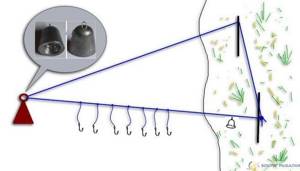
The situation is similar with the bottom elastic band, equipped with a rubber shock absorber that pulls the fishing line with hooks into the water. The weight for the elastic band is brought in by boat or thrown by hand, but this method is much worse, because it is very difficult to throw a heavy load over a long distance.
During fishing, the rubber bottom is sometimes in a tense state and pulls the light load closer to the shore, which is extremely undesirable. This happens especially often when fishing with an elastic band, in the current, which itself tightens the shock absorber. Therefore, the elastic band also requires a heavy load to ensure tension on the shock absorber and its fixation.
Fishing with a ring is carried out from an anchored boat, but even in this case, the load keeps the cord taut so that the tackle with the ring slides freely into the water and rises up. Here, too, you need a weight with an eye, and fishermen cast such weights from lead with their own hands.
It is easier to buy sliding and blind weights for donks in a store, although in order to save money they are also made at home.
Methods for installing feeders
To install a feeder on a fishing line, you can use several methods:
How to catch more fish?
I have been active fishing for quite some time and have found many ways to improve the bite. And here are the most effective:
- . Attracts fish in cold and warm water with the help of pheromones included in the composition and stimulates its appetite. It is a pity that Rosprirodnadzor wants to impose a ban on its sale.
- More sensitive gear.
You can find reviews and instructions on other types of gear on the pages of my website. - Lures using pheromones.
You can get the rest of the secrets of successful fishing for free by reading my other materials on the site.
- Install the anti-twist tube. To do this, you need to stretch the fishing line through the tube and secure it with a bead or lead pellet. The bend has a swivel, which makes it possible to quickly change the feeder to another.
- Gardner rig. A very simple method that does not take much time. At 0.5 meters of fishing line, a loop is made from the end, through which a swivel with a carabiner is passed. After 20 cm, make another loop to attach the leash.
- Another way is loops. With their help, the equipment becomes very sensitive and reacts to any movement. To make loops, take a fishing line with a diameter of at least 0.2 mm. For a symmetrical rig, you will need a fishing line about a meter long. It is folded in half. For asymmetrical - leave one end a little longer. A loop is made at the bend point to attach the leash, and then a swivel is attached to it. After that, all that remains is to make a loop from the double fishing line, and the feeder is attached.
Main line for donkey
The main line, or the base of the donkey, is an important element necessary for casting tackle and landing fish.
The following is used as a basis for donks:
- monofilament lines;
- braided cords;
- fluorocarbon lines.
Fluorocarbon lines
Fluorocarbon is used least often and only when the inconspicuousness of the equipment is critical. This is the most expensive material and is most often used in winter fishing, when the equipment is much shorter than summer, and in carp fishing, for making leashes.
Advantages of fluorocarbon:
- stealth;
- abrasion resistance;
- rigidity;
- resistance to aggressive environments.
Disadvantages of fluorocarbon lines:
- high price;
- low tensile strength compared to other materials;
- a large number of fakes.
Monofilament lines
Monofilament fishing line leads in popularity among all types of main fishing lines for donks, and this is not surprising, its advantages:
- lowest price compared to other materials;
- extensibility;
- large selection of colors;
- There are both hard and soft monofilament lines;
- there is a monofilament with and without memory;
- large selection of diameters.
That is, when purchasing a monofilament fishing line for the base of the donkey, the angler has the opportunity to choose exactly the option that will suit him for the existing fishing conditions. When landing trophy fish, the extensibility of the warp plays an important role, and monofilament fishing line helps to “work off” its jerks. But when hooking a donkey thrown over a long distance, this same stretchability plays a negative role and you have to make it stronger.
For casting, a thick fishing line is selected, resistant to stress and durable, with high strength at the knots. Unlike other types of donkeys, the base on a cast line almost never changes, and besides, it’s easier to cast a thick line by hand, as well as to land fish.
The fisherman selects the color of the base so that it is invisible in the reservoir where fishing is carried out. As a last resort, a colorless base that is hardly noticeable in any water will do.
Important! Do not forget to regularly check the condition of the main fishing line on the bottom, as it is negatively affected by the sun and moisture.
The cost of monofilament fishing line is less than braided cord or fluorocarbon and this is its important advantage. Of course, expensive monofilament materials are also sold, but they are mainly used in sport and trophy fishing, where the implementation of each bite is very important. For amateur fishing with bottom gear, such expensive purchases are not needed, and there are a lot of budget options.
Network
Braided fishing lines for donkeys are rarely used in amateur fishing, but fans of feeder fishing use them much more often. With a low-stretch base, too sharp hooks are not needed, even when fishing at a distance. The main advantage of such fishing lines is their high knot strength, and in this regard they outperform both monofilament and fluorocarbon.
The thinner the base of the donkey, the easier it is to throw the tackle over a long distance, but strength also matters. Therefore, instead of thick monofilament fishing line, they take braided line, and its strength is enough for both power casting and fishing for trophies.
Advantages of braided lines for donks:
- low stretchability;
- knot strength, especially compared to competitors;
- durability.
In this case we are talking about high-quality braided fishing lines from reputable manufacturers. Unfortunately, unscrupulous sellers offer low-quality braid in branded packaging, but not every angler will be able to recognize a fake just by its appearance.
As a result, it turns out that after several fishing trips, the braided line on the bottom sheds, or even loses its color altogether. And its strength after a short stay in the water deteriorates significantly and this affects the results of fishing.
It seems to the fisherman that he can confidently reel in a solid trophy with an expensively purchased braided line, but even when fishing, the tackle breaks due to poor-quality cord. To avoid such situations, buy braided lines from trusted and reputable stores, then there will be no unpleasant surprises while fishing.
The low stretchability of braided fishing line is not always an advantage, because when fishing for heavy fish, the stretchability of the monofilament “forgives” the fisherman technical mistakes. Therefore, during such fishing, special attention is paid to the correct setting of the reel clutch, which provides convenience when fishing for a trophy.
An unpleasant surprise for anglers is that, unlike monofilament fishing line, which breaks at the knots, braided line can break anywhere. This applies not only to cheap fishing lines, but also to high-quality materials. So, this circumstance must be taken into account when choosing the basis for your donka.
Disadvantages of braided fishing line for donkey:
- high price;
- low stretchability;
- softness;
- the cord cuts the rings of a budget spinning rod with frequent casts;
- color selection is limited.
For novice anglers, the difficulty of using braided cord as a base for a donkey is that it gets wet and gets tangled more often than monofilament line.
It is much more difficult to untangle the “beard” on the cord, and given its higher cost, you don’t want to cut off the unraveled pieces. As a result, precious time is lost while fishing, and if the cord is lost, money is also lost.
Braided cords are not used as a basis for the following types of donks:
- snack;
- Donka gum;
- carousel;
- ring;
- donk with side outlet.
It is allowed to use braided cord in donks of the following types:
- flat method;
- makushatnik;
- feeder equipment;
- killers of crucian carp, carp, silver carp.
Where a clear and focused hook is important, braided lines have advantages, but the choice is made taking into account their disadvantages. When fishing with braid, you need to be careful and before each cast, make sure that there are no snags or twists, and that the base passes freely through the rings.
One braided fishing line is usually enough for the whole season, so if you decide to make the base of the donkey from braid, choose proven and reliable materials. Another disadvantage of using braid with donks and inexpensive reels is that when casting and reeling, the loop is thrown off and puffs and knots appear due to inattention. When casting strongly, braided fishing line sails more than monofilament, especially if it is not new, but already used.
Conclusion: Before choosing the material of the main fishing line, you need to evaluate the advantages and disadvantages of one or another option and choose a fishing line that is optimally suited for a particular body of water where fishing will take place.
Fastening with swivels and carabiners
Plus, quite often anglers use a knot called “Improved Clinch”. To say that it is very strong is to say nothing: its strength reaches ninety-five percent, which is an excellent result and gives every reason to believe that even the largest specimen of a pond (weighing up to ten kilograms) will not be able to tear the leash from the main fishing line (naturally , both the fishing line and the leash itself must withstand such weight. There is no other way).
And the process of its complete production is as follows:
- The free end of the fishing line is threaded through the swivel of the leash.
- Then, the same end wraps the fishing line around its axis about four or even five times, without tightening the knot.
- Then you need to pass the end through the hole formed near the swivel ring.
- And finally, after wetting the knot first, tighten the knot in the usual way.
But it is worth considering that it is not recommended to use this type of knot if the reel is wound with braided fishing line rather than ordinary one.
It was mentioned above that the leash has a swivel. But for him to appear there, he needs to be tied. To do this, you can use a simple unit, which is made according to the following scheme:
Scheme for tying the swivel to the fishing line
Insert the swivel.
- Fold part of the leash in half.
- Fold the folded part again.
- The fishing line is fixed a couple of centimeters from the bend (by hand).
- Make two or three turns around the line.
- A double fishing line is threaded into the resulting loop at the end of the leash.
- The knot is wetted and tightened.
- Everything that is three or four millimeters from the end of the knot is cut off.
Such a knot, by the way, turns out to be motionless.
In addition, you can attach a side lead leash using a swivel and carabiner. And this is done like this:
- A sinker is attached to the end of the main line.
- The leash is tied twenty or thirty centimeters above the sinker (here it is important to take into account that the lead leash must be perpendicular to the main line).
And we need to say more about the second point. If you tie the leash directly to the fishing line, the chance of tangling this gear sharply increases. If you do this with a swivel and a carabiner, then the likelihood of entanglement is reduced significantly. And then you need to tie the swivel itself with a carabiner to the main fishing line, and attach a leash to it.
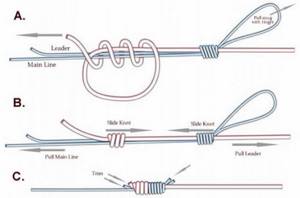
Methods for tying a leash to a fishing line
